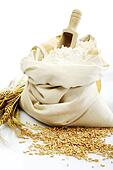Bajra known as Pearl millet is most widely grown in Asia and Africa. With 8g of protein, 2.4g of fat, 3.1g of fibre, 57g of carbohydrates, 5mg of sodium, o.3mg of thiamin, 3.2mg of niacin, 106mg of magnesium, 2.2mg of zinc per 100g of the millet, it ranks sixth most important grain in the world. Normally this millet is consumed as roti and as porridge. It can also be mixed with wheat flour to make breads, cakes, cookies, muffins and biscuits.
 |
| WHOLE BAJRA |
Considering the health benefits of Bajra, it is gluten and cholesterol free and is a source of
- Iron
- Cholesterol lowering Phytochemicals
- Calcium
- Energy
- Unsaturated Fats
- B- Vitamins
- Manganese
- Potassium
- Zinc
- Copper and
- Magnesium
The magnificent fact is that, its rich in Protein and it provides all the 8 essential Amino acids( Phenyl alanine, Leucine, Isoleucine, Lysine, Tryptophan, Threonine, Valine,& Methionine ) to our body. And another interesting fact is that, is helps to tone up your skin while loosing weight and hence prevents it from sagging!
